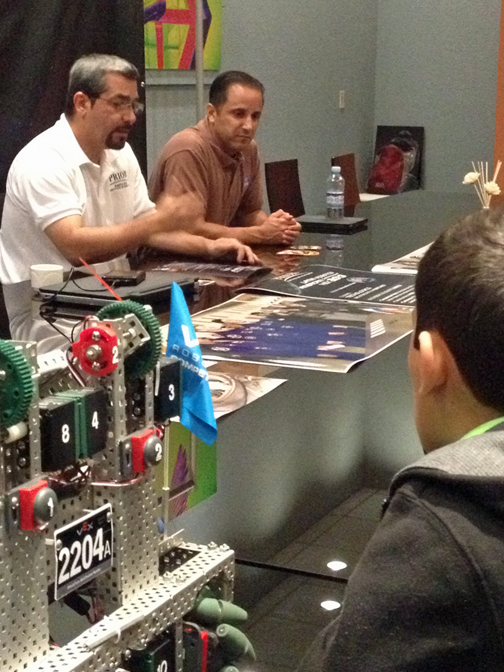4th, 8th grade students in Puerto Rico fall short in math


The 2013 assessment results showed that 11 percent of fourth-graders in Puerto Rico and 5 percent of eighth-graders in public schools performed at or above the basic level; conversely, 89 percent of fourth-graders and 95 percent of eighth-graders scored below that level.
Many of Puerto Rico’s fourth- and eighth-grade public school students are falling short in mathematics achievement, according to “The Nation’s Report Card: 2013 Mathematics Assessment in Puerto Rico.”
The results in 2011 and 2013 come from the National Assessment of Educational Progress (NAEP), which measures the mathematics knowledge and skill of students in Puerto Rico. The assessment provides educators in Puerto Rico with information to gauge the achievement of their students compared to that of U.S. students and over time.
The 2013 Spanish-language mathematics assessment marks the first time that Puerto Rico has been able to use NAEP results to establish a valid comparison to the last assessment in 2011. Prior to 2011, the assessment was carefully redesigned to ensure an accurate assessment of students in Puerto Rico.
Results from assessments in Puerto Rico in 2003, 2005 and 2007 cannot be compared, in part because of the larger-than-expected number of questions that students either didn’t answer or answered incorrectly, making it difficult to precisely measure student knowledge and skills.
The National Center for Education Statistics, which conducts NAEP, administered the NAEP mathematics assessment in 2011. But those results have not been available until now, as it was necessary to replicate the assessment in 2013 to ensure that valid comparisons could be made.
“The ability to accurately measure student performance is essential for improving education,” said Terry Mazany, chairman of the National Assessment Governing Board, which oversees NAEP.
“With the support and encouragement of education officials in Puerto Rico, this assessment achieves that goal. This is a great accomplishment and an important step forward for Puerto Rico’s schools and students,” he said.
NAEP assessments report performance using average scores and percentages of students at or above three achievement levels: basic, proficient and advanced. The 2013 assessment results showed that 11 percent of fourth-graders in Puerto Rico and 5 percent of eighth-graders in public schools performed at or above the basic level; conversely, 89 percent of fourth-graders and 95 percent of eighth-graders scored below that level.
The basic level denotes partial mastery of the knowledge and skills needed for grade-appropriate work. One percent or fewer of students in either grade scored at or above the proficient level, which denotes solid academic performance. Only a few students scored at the advanced level.
No significant changes
The 2013 report showed no significant changes from 2011 in average scores or achievement levels at either grade level. The average fourth-grade score was 182, which was 32 points shy of the 214 needed to be designated as basic; the average eighth-grade score of 218 was 44 points short of basic’s 262-point cutoff.
Students in Puerto Rico also scored lower than U.S. students overall and also U.S. students eligible for the National School Lunch Program, which provides free or reduced-price lunches to students from low-income families. In Puerto Rico, 100 percent of public school students are eligible for the lunch program, compared with about 50 percent of public school students in the United States.
The 2013 assessment was administered to representative samples constituting about 4,600 fourth-grade students from 150 public schools and 5,200 eighth-grade students from 120 public schools in Puerto Rico. NAEP administers assessments only to public school students in Puerto Rico, just as it includes only public school student results in its state-by-state reporting of NAEP results.
In Puerto Rico, about 23 percent of students in kindergarten through 12th grade attended private schools as of the 2011-2012 school year, compared with 10 percent in the United States. Puerto Rico results are not part of the results reported for the NAEP national sample.
Responses to teacher questionnaires accompanying the assessment also found differences in the classrooms for fourth- and eighth-grade students in Puerto Rico compared with those of the U.S. For example, in 2013 students in Puerto Rico were less likely than their U.S. public school peers to be assigned to mathematics classes by ability: 2 percent in Puerto Rico versus 21 percent in the U.S. for fourth-graders, and 15 percent versus 63 percent for eighth-graders.
In addition, many of Puerto Rico’s fourth-graders receive less time in mathematics instruction — 3 percent received seven or more hours of mathematics instruction per week, compared with 36 percent in the U.S. public schools.
Also, teachers at both grade levels in Puerto Rico were more likely to report that their school systems did not provide or provided only some of the materials and resources needed for mathematics instruction. In Puerto Rico, 80 percent of fourth-grade teachers and 87 percent of eighth-grade teachers reported that, compared with 28 percent at both grade levels in the United States.
The technical enhancements to the 2011 and 2013 Puerto Rico assessments included adding special sections of mathematics questions — administered in both Puerto Rico and the nation — to more precisely and reliably measure student achievement at the lower end of the assessment’s scoring scale.
The No Child Left Behind Act requires Puerto Rico to participate in the NAEP mathematics assessment at grades 4 and 8 as a condition of receiving Title I funds. With the improved, valid assessment, Puerto Rico could be included as soon as 2015 in NAEP’s broader report on mathematics, which now covers all 50 U.S. states, the District of Columbia and U.S. Department of Defense schools.
Puerto Rico did not participate in the NAEP reading assessment due to the NAEP requirement to measure reading in English. Spanish is the primary language of instruction in Puerto Rico.








